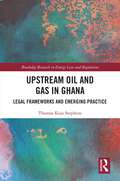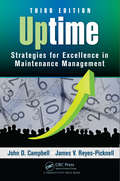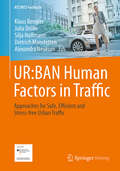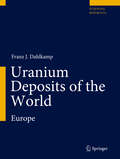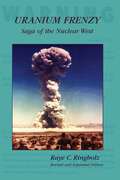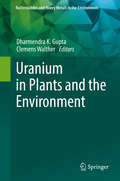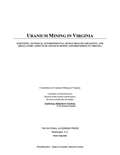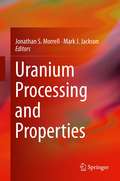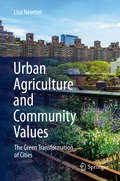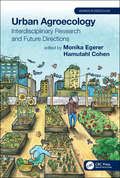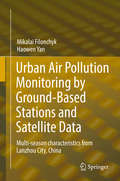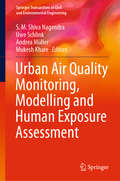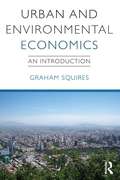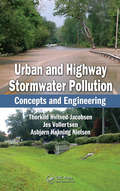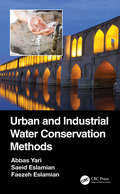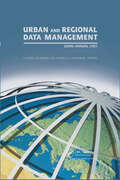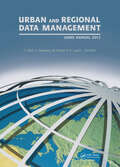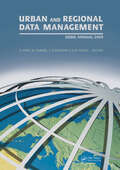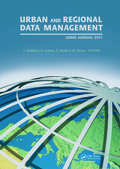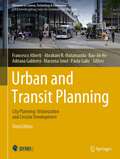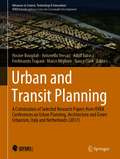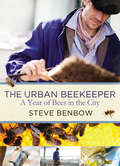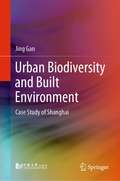- Table View
- List View
Upstream Oil and Gas in Ghana: Legal Frameworks and Emerging Practice (Routledge Research in Energy Law and Regulation)
by Thomas Kojo StephensThis book explores the myriad issues that play out in the upstream petroleum industry of Ghana from a legal perspective. Focusing on Ghana as an emerging petroleum country, Thomas Kojo Stephens begins by examining whether the existing constitutional framework will be effective in governing the expanding oil and gas sector. Drawing on various approaches proffered by other experts in the field, Stephens looks at possible institutional structures that could be put in place and juxtaposes these ideas with the experience of Ghana to test the efficacy of these proposals. He also explores the types of contractual frameworks currently implemented in Ghana for comparison with other emerging petroleum economies, examining the barriers to effectiveness, novel provisions that must be incorporated, and lessons learned from other regions. Finally, the book highlights how vital it is for the Ghanaian State to monitor the use of petroleum revenue and make ethical investment decisions that prioritize the interests of Ghanaian citizens. Upstream Oil and Gas in Ghana will be of great interest to students and scholars of energy law and policy, oil and gas management, and African Studies more broadly, as well as those working in the upstream petroleum industry.
Uptime: Strategies for Excellence in Maintenance Management, Third Edition
by John D. Campbell James V. Reyes-Picknell Hyung Sik KimUptime describes the combination of activities that deliver fewer breakdowns, improved productive capacity, lower costs, and better environmental performance. The bestselling second edition of Uptime has been used as a textbook on maintenance management in several postsecondary institutions and by many companies as the model framework for their mai
UR:BAN Human Factors in Traffic
by Alexandra Neukum Dietrich Manstetten Silja Hoffmann Julia Drüke Klaus BenglerThis book gives a unique insight in approaches that optimize driver assistance and driver information systems for the urban usage. Furthermore innovative test regimes for controllability testing and new evaluation techniques like networked simulators and virtual reality test-beds are described including statistical methodologies.
Uranium Deposits of the World
by Franz J. DahlkampUranium Deposits of the World, in four volumes, comprises an unprecedented compilation of data and overviews of the key uranium regions throughout the globe. It offers not only a complete uranium-resource reference based on the latest research but also access to previously unavailable data. Each country and region receives an analytical overview followed by the detailed geologically- and economically-relevant synopsis of the individual regions and fields, including: location and magnitude of uranium districts and deposits; principal features of uranium districts; and characteristics of selected deposits. The description of districts and deposits includes sections on geology, alteration, mineralogy, shape and dimensions, ore controls or recognition criteria, and metallogenetic aspects. A typological classification of uranium deposits is added to give an overview of principal criteria of deposit types and related nomenclature. The set also provides readers access to the voluminous literature via the comprehensive bibliography of uranium-related publications. Abundantly illustrated with information-laden maps and charts throughout, this reference work is an indispensable tool for geologists, mining companies, government agencies, and others with interest in key natural resources. The four volumes of Uranium Deposits of the World, available as set, cover the world's populated continents: Asia; Europe; Australia, Oceania, and Africa; and USA, and Latin America.
Uranium Frenzy: Saga of the Nuclear West
by Raye RingholzNow expanded to include the story of nuclear testing and its consequences, Uranium Frenzy has become the classic account of the uranium rush that gripped the Colorado Plateau region in the 1950s. Instigated by the U.S. government's need for uranium to fuel its growing atomic weapons program, stimulated by Charlie Steen's lucrative Mi Vida strike in 1952, manned by rookie prospectors from all walks of life, and driven to a fever pitch by penny stock promotions, the boom created a colorful era in the Four Corners region and Salt Lake City (where the stock frenzy was centered) but ultimately went bust. The thrill of those exciting times and the good fortune of some of the miners were countered by the darker aspects of uranium and its uses. Miners were not well informed regarding the dangers of radioactive decay products. Neither the government nor anyone else expended much effort educating them or protecting their health and safety. The effects of exposure to radiation in poorly ventilated mines appeared over time.
Uranium in Plants and the Environment (Radionuclides and Heavy Metals in the Environment)
by Dharmendra K. Gupta Clemens WaltherIn recent years, radioactive contamination in the environment by uranium (U) and its daughters has caused increasing concerns globally. This book provides recent developments and comprehensive knowledge to the researchers and academicians who are working on uranium contaminated areas worldwide. This book covers topics ranging from the beginning of the nuclear age until today, including historical views and epidemiological studies. Modelling practices and evaluation of radiological and chemical impact of uranium on man and the environment are included. Also covered are analytical methods used for the determination of uranium in geo/bio environments. Some chapters explore factors which influence uranium speciation and in consequence plant uptake/translocation. Last but not least, several chapters provide approaches and practices for remediation of uranium contaminated areas.
Uranium Mining in Virginia: Scientific, Technical, Environmental, Human Health and Safety, and Regulatory Aspects of Uranium Mining and Processing in Virginia
by Committee on Uranium Mining in VirginiaUranium mining in the Commonwealth of Virginia has been prohibited since 1982 by a state moratorium, although approval for restricted uranium exploration in the state was granted in 2007. Uranium Mining in Virginia examines the scientific, technical, environmental, human health and safety, and regulatory aspects of uranium mining, milling, and processing as they relate to the Commonwealth of Virginia for the purpose of assisting the Commonwealth to determine whether uranium mining, milling, and processing can be undertaken in a manner that safeguards the environment, natural and historic resources, agricultural lands, and the health and well-being of its citizens. According to this report, if Virginia lifts its moratorium, there are "steep hurdles to be surmounted" before mining and processing could take place within a regulatory setting that appropriately protects workers, the public, and the environment, especially given that the state has no experience regulating mining and processing of the radioactive element. The authoring committee was not asked to recommend whether uranium mining should be permitted, or to consider the potential benefits to the state were uranium mining to be pursued. It also was not asked to compare the relative risks of uranium mining to the mining of other fuels such as coal. This book will be of interest to decision makers at the state and local level, the energy industry, and concerned citizens.
Uranium Processing and Properties
by Jonathan S. Morrell Mark J. JacksonUranium Processing and Properties describes developments in uranium science, engineering and processing and covers a broad spectrum of topics and applications in which these technologies are harnessed. This book offers the most up-to-date knowledge on emerging nuclear technologies and applications while also covering new and established practices for working with uranium supplies. The book also aims to provide insights into current research and processing technology developments in order to stimulate and motivate innovation among readers. Topics covered include casting technology, plate and sheet rolling, machining of uranium and uranium alloys, forming and fabrication techniques, corrosion kinetics, nondestructive evaluation and thermal modeling.
Urban Adaptation to Climate Change: The Role of Urban Form in Mediating Rising Temperatures (SpringerBriefs in Environmental Science)
by Vivek Shandas Cynthia Skelhorn Salim FerwatiThis book presents the findings of a three-year study on urban heat in Doha, Qatar, and discusses guidelines and strategies for planning agencies to consider in the context of moderating temperatures to provide pedestrians with greater access to outdoor spaces and greater choice in modes of transport. If modifying urban form can reduce extreme temperatures in one of the hottest places on the planet, then perhaps other communities can learn how to create livable cities during a time of rapid changes to the climate. In fact, despite the periods of extreme heat, strategic planning and management of urban areas can improve residents’ and visitors’ ability to live, work, and move throughout the city comfortably. Doha, Qatar, a city with one of the most extreme climates on earth, has undergone rapid development over the past 40 years. Although cities in the Middle East are expanding at three times the international average (UN Report, 2012), the rapid population and physical growth remain largely unexamined, particularly in terms of the unique conditions, qualities, and characteristics that give rise to these emerging centres. Speed, quality, and extent of urbanization impact neighbourhood-scale environmental conditions, and this book provides evidence that urban forms and materials can help to mediate temporal variation in microclimates and that landscape modifications can potentially reduce temperatures and increase accessibility to outdoor environments. By applying the lessons in this book, communities around the world can better adapt to the increasing frequency, duration and intensity of extreme heat.
Urban Agriculture and Community Values: The Green Transformation of Cities
by Lisa NewtonThis book addresses the evolving crisis in agriculture and sketches the 'community economy' that grounds agricultural enterprise more accurately than the industrial model. In its current practice, agriculture is (in the United States but increasingly in the rest of the world) unsustainable and destructive. The most immediately unsustainable feature of industrial agriculture is its dependence on the products of petroleum—as feedstock for fertilizers, herbicides, and pesticides, and as fuel for the farm machinery and transport of agricultural products into the cities. The problems of agriculture and in general the food systems to which it is attached range from the vulnerability of monocultures to new and stronger pests to the emerging medical problem of obesity. The need for agricultural reform is widely acknowledged; one part of the new work being done suggests that food production in the cities may solve several of its problems at once. This book is suitable for both undergraduate and graduate students in agriculture and environmental studies.
Urban Agriculture in Public Space: Planning and Designing for Human Flourishing in Northern European Cities and Beyond (GeoJournal Library #132)
by Deni Ruggeri Beata SirowyThis open access book discusses urban agriculture initiatives integrated in public space of dense inner-city neighbourhoods, thereby ensuring its accessibility for large and diverse segments of urban populations. It specifically focuses on the potential impacts of urban agriculture on human well-being (both on individual and community levels), and how planning, design, policy and management practices can maximize these impacts. The book addresses urban agriculture on both a micro and macro scale to facilitate a transition to more sustainable lifestyles and enhance the quality of urban life. It also discusses ways to permanently integrate urban agriculture in existing and planned public spaces in a visually attractive, socially inclusive, and democratic manner to claim and reclaim the right to the city. Based on the research outcomes of the project “Cultivating Public Space: urban agriculture as a basis for human flourishing and sustainability transition in Norwegian cities” funded by the Research Council of Norway, the book emerges from a Norwegian context, but extends to include international urban agriculture cases from the Netherlands, Denmark, the UK and more. By including a diversity of voices and cultural perspectives, the editors aimed to make this book engaging and relevant to an international audience of researchers, policy makers, urban designers, planners, educators, community activists, residents, and public space users of the sustainable, compact city of today and the future.
Urban Agroecology: Interdisciplinary Research and Future Directions (Advances in Agroecology #23)
by Monika Egerer Hamutahl CohenToday, 20 percent of the global food supply relies on urban agriculture: social-ecological systems shaped by both human and non-human interactions. This book shows how urban agroecologists measure flora and fauna that underpin the ecological dynamics of these systems, and how people manage and benefit from these systems. It explains how the sociopolitical landscape in which these systems are embedded can in turn shape the social, ecological, political, and economic dynamics within them. Synthesizing interdisciplinary approaches in urban agroecology in the natural and social sciences, the book explores methodologies and new directions in research that can be adopted by scholars and practitioners alike. With contributions from researchers utilizing both social and natural science approaches, Urban Agroecology describes the current social-environmental understandings of the science, the movement and the practices in urban agroecology. By investigating the role of agroecology in cities, the book calls for the creation of spaces for food to be sustainably grown in urban spaces: an Urban Agriculture (UA) movement. Essential reading for graduate students, practitioners, policy makers and researchers, this book charts the course for accelerating this movement.
Urban Air Pollution Monitoring by Ground-Based Stations and Satellite Data: Multi-season Characteristics From Lanzhou City, China
by Haowen Yan Mikalai FilonchykThis book examines air pollution of a big city using multi-year and multi-season data from ground-based air monitoring stations and satellite sounding data, which provides more clear and detailed information on the main sources of air pollution, the long-term trend of pollution, the influence of meteorological parameters on pollution levels, and trajectories of polluted air masses. For example, the book shows that particulate matter from local sources is transported from deserts to create air quality challenges. It also analyzes the effects of desert and semi-desert landscapes on high concentrations of pollutants.
Urban Air Quality Monitoring, Modelling and Human Exposure Assessment (Springer Transactions in Civil and Environmental Engineering)
by S. M. Shiva Nagendra Uwe Schlink Andrea Müller Mukesh KhareThis contributed volume is primarily intended for graduate and professional audiences. The book provides a basic understanding of urban air quality issues, root causes for local and urban air pollution, monitoring and modelling techniques, assessment, and control options to manage air quality at local and urban scale. The book also offers useful information on indoor air quality and smart sensors, which are gaining much importance in current times.
Urban and Environmental Economics: An Introduction
by Graham SquiresThe importance of the built environment to environmental protection is well established, with strict environmental regulations now a feature of the working lives of planners, contractors, building designers, and quantity surveyors alike. Those new to, or preparing to join this industry must have an understanding of how their environmental responsibilities relate to their professional responsibilities in economic terms. Designed as an introductory textbook, Urban and Environmental Economics: An Introduction provides the background information from these disciplines to understand crucial tools and economic techniques. A broad range of theories of the natural and built environments and economics are explained, helping the reader develop a real understanding of the topics that influence this subject, such as: the history of economic thought on the built environment the economics of shared space in the built environment cost-benefit analysis and discounting macro-economic tools, measures, and policy sustainable development resource valuation. Illustrated throughout, and with lists of further reading in every chapter, this book is ideal for students at all levels who need to get to grips with the economics of the environment within a built environment context. Particularly useful to those studying planning, land economy, environmental management, or housing development.
Urban and Highway Stormwater Pollution: Concepts and Engineering
by Thorkild Hvitved-Jacobsen Jes Vollertsen Asbjorn Haaning NielsenAs the world population grows, already burgeoning cities are becoming taxed in every conceivable way. One topic that receives few headlines, but significantly impacts an area's quality of health and economic development is the challenge to maintain sustainable urban drainage (SUD). Poor drainage can hamper transportation, add to problems of polluti
Urban and Industrial Water Conservation Methods
by Abbas Yari Saeid Eslamian Faezeh EslamianUrban and Industrial Water Conservation Methods provides comprehensive and practical information regarding water use for various different sectors and describes the most suitable conservation devices and techniques to reduce water consumption in urban environments. It demonstrates how these conservation devices and best practices can greatly and quickly increase the efficiency of water use in both new and existing buildings. Features: Examines conservation devices and techniques across residential, commercial, and institutional sectors. Provides practical advice on implementing water conservation methods for users across various industries. Explains how to quickly improve water efficiency by using cost-effective water-saving devices and techniques. Includes relevant international case studies to reinforce the content. Written by practicing water conservation consultants for a wide audience, including municipality authorities and decision-makers, researchers, and students alike, Urban and Industrial Water Conservation Methods applies to residential, commercial, institutional, and industrial end users.
Urban and Regional Data Management: UDMS 2007 Annual
by Volker Coors Massimo RumorSpatial technologies like GIS, CAD, and spatial DBMS have proved their applicability and usability in almost every sector of urban development. Urban Planning Systems, Public Participation Systems, and others have been continuously developed and improved contributing to better decision making, communicating ideas between different actors as well as
Urban and Regional Data Management: UDMS Annual 2013
by Claire Ellul Sisi Zlatanova Massimo Rumor Robert LauriniThe Urban Data Management Society has organised international symposia at various locations throughout Europe since 1971, and UDMS 2013 marks its second visit to London. From its outset, UDMS has highlighted changes and trends in urban data and urban data management. However, the rate of emergence of new data and new technologies has never been as
Urban and Regional Data Management: UDMS 2009 Annual
by Alenka Krek Massimo Rumor Sisi Zlatanova Elfriede FendelNatural and human activities change the environment we are living in and consequently impact the quality of life. Analysing these dynamics leads to a better understanding of urban change and facilitates urban development. Research related to the management of urban data has a long tradition. Through the years a variety of challenging research quest
Urban and Regional Data Management: UDMS Annual 2011
by Sisi Zlatanova Hugo Ledoux Elfriede FendelHuman activities as well as various natural phenomena change the environment and impact on the quality of life. Analysis of those dynamics is required for a better understanding of urban modifications, and to facilitate urban growth and development. Research related to the management of urban data has a long tradition. Through the years a variety o
Urban and Transit Planning: City Planning: Urbanization and Circular Development (Advances in Science, Technology & Innovation)
by Francesco Alberti Abraham R. Matamanda Bao-Jie He Adriana Galderisi Marzena Smol Paola GalloThis book represents a compilation of research in sustainable architecture and planning. Its main focus is offering strategies and solutions that help reducing of the negative impacts of buildings on the environment and emphasizing the suitable management of available resources. By tackling the topic of sustainability from a historical perspective and also as a vision for the future, the book in hands provides new horizons for engineers, urban planners and environmentalists interested in the optimization of resources, space development, and the ecosystem as a whole to address the complex unresolved problems our cities are facing. This book is a culmination of selected research papers from IEREK’s sixth edition of the International Conference on Urban Planning & Architectural Design for Sustainable Development (UPADSD) held online in collaboration with the University of Florence, Italy (2021) and the first edition of the International Conference on Circular Economy for Sustainable Development (CESD) held online in collaboration with the University of Salento, Lecce, Italy (2021).
Urban and Transit Planning: A Culmination of Selected Research Papers from IEREK Conferences on Urban Planning, Architecture and Green Urbanism, Italy and Netherlands (2017) (Advances in Science, Technology & Innovation)
by Nancy Clark Hocine Bougdah Antonella Versaci Adolf Sotoca Ferdinando Trapani Marco MiglioreA volume of five parts, this book is a culmination of selected research papers from the second version of the international conferences on Urban Planning & Architectural Design for sustainable Development (UPADSD) and Urban Transit and Sustainable Networks (UTSN) of 2017 in Palermo and the first of the Resilient and Responsible Architecture and Urbanism Conference (RRAU) of 2018 in the Netherlands. This book, not only discusses environmental challenges of the world today, but also informs the reader of the new technologies, tools, and approaches used today for successful planning and development as well as new and upcoming ones. Chapters of this book provide in-depth debates on fields of environmental planning and management, transportation planning, renewable energy generation and sustainable urban land use. It addresses long-term issues as well as short-term issues of land use and transportation in different parts of the world in hopes of improving the quality of life. Topics within this book include: (1) Sustainability and the Built Environment (2) Urban and Environmental Planning (3) Sustainable Urban Land Use and Transportation (4) Energy Efficient Urban Areas & Renewable Energy Generation (5) Quality of Life & Environmental Management Systems. This book is a useful source for academics, researchers and practitioners seeking pioneering research in the field.
The Urban Beekeeper: A Year of Bees in the City
by Steve BenbowAt a time when the UK bee population is in decline there's no better way to make a difference than to start up your own beehive. Steve Benbow's enormous success with urban beekeeping show's how easy it is to keep bees, whether you're in the city or in the countryside, a beginner or an experienced beekeeper, and you'll never look back once you've tasted your very own sticky, golden honey, or lit a candle made from the beeswax from your beehive.Steve Benbow is a visionary beekeeper who started his first beehive ten years ago on the roof of his tower block in Bermondsey and today runs 30 sites across the city. His bees live atop the Tate Modern and Tate Britain, Fortnum & Mason and the National Portrait Gallery, and he supplies honey to the Savoy tearooms, Harvey Nichols, Harrods and delis across London. His bees forage in parks, cemeteries, along railway lines and in window boxes, and because of the diversity of the plants and trees in the city, produce far richer honey and greater yields than they would in rural areas.The Urban Beekeeper is a fact-filled diary and practical guide to beekeeping that follows a year in the life of Steve and his bees and shows how keeping bees and making your own delicious honey is something anyone can do. It is a tempting glimpse into a sunlit lifestyle that starts with the first rays of the morning and ends with the warm glow of sunset, filled with oozing honeycomb, recipes for sensational honey-based dishes, and honey that tastes like sunshine. A hugely affectionate but practical diary of a beekeeper's year and the immense satisfaction of harvesting your own delicious honey. Read it and join the revolution.
Urban Biodiversity and Built Environment: Case Study of Shanghai
by Jing GanThis book proposes the concept of urban multiple habitats and then analyzes its corresponding classification, function and potential supply capability. It provides an analysis framework for studying the relationship between urban biodiversity and built environment, and for considering the loss of urban habitats caused by high-density development. It argues that urban biodiversity is a key indicator for assessing urban ecosystem services. On this basis, the book then presents a case study mainly focusing on wild birds in Shanghai, as urban wild birds and their species could be viewed as an essential indicator for evaluating healthy ecosystem of contemporary cities. Based on the empirical findings, the book proposes an assessment model for urban biodiversity performance and a range of principles, strategies and key indicators regarding the optimization of urban planning and design practice to enhance urban biodiversity performance.
